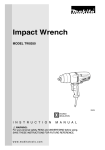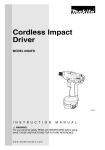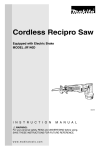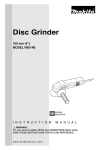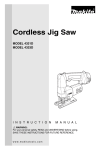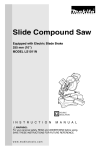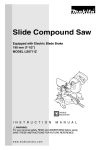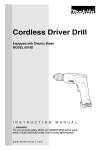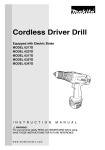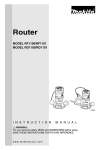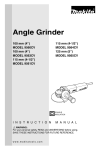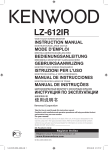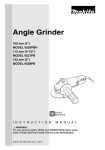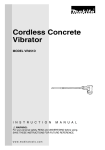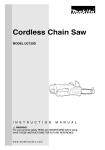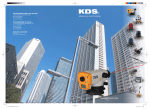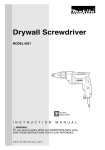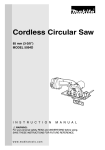Download Makita UC170D User's Manual
Transcript
Cordless PVC Saw MODEL UC170D 002270 I N S T R U C T I O N M A N U A L WARNING: For your personal safety, READ and UNDERSTAND before using. SAVE THESE INSTRUCTIONS FOR FUTURE REFERENCE. w w w. m a k i t a t o o l s. c o m SPECIFICATIONS Model UC170D Chain speed per minute 200 m/min. Length of guide bar 170 mm (6-11/16”) Saw chain Type For PVC tubing Pitch 3/16” No. of drive links 62 Overall length 510 mm (20”) Net weight 2.1 kg (4.6 lbs) Battery Charger DC1414 Input A. C. only 50 Hz - 60 Hz Output D. C. 7.2 V - 14.4 V Battery Cartridge 1222 Voltage Charging time 1234 1235 12 V 45 min. 60 min. 70 min. • Manufacturer reserves the right to change specifications without notice. • Specifications may differ from country to country. INPORTANT SAFETY INSTRUCTIONS USA014-1 WARNING: WHEN USING A CORDLESS PVC SAW, BASIC SAFETY PRECAUTIONS SHOULD ALWAYS BE FOLLOWED TO REDUCE THE RISK OF FIRE, ELECTRIC SHOCK, AND INJURY TO PERSONS, INCLUDING THE FOLLOWING: READ ALL INSTRUCTIONS 1. Keep Work Area Clean Cluttered areas invite injuries. Do not start cutting until you have a clear work area and secure footing. 2. Consider Work Area Environment Do not expose saw to rain. Do not use saw 2 in damp or wet locations. Do not use saw in presence of flammable liquids or gases. 3. Guard Against Electric Shock Prevent body contact with grounded surfaces. For example: metal pipes, wire fences. 4. Keep Children Away Do not let visitors contact saw. All visitors should be kept away from work area. 5. Store Idle Saw When not in use, saws should be stored in a dry, and high or locked-up place - out of the reach of children. When storing saw, use a scabbard or carrying case. 6. Do not Force Saw It will do the job better and safer at the rate for which it was intended. 7. Use Right Tool Cut PVC tubing only. Do not use saw for purpose not intended - for example - Do not use saw for cutting wood, metal, masonry materials. 8. Dress properly Do not wear loose clothing or jewelry. They can get caught in moving parts. Rubber gloves and non-skid footwear are recommended when working outdoors. Wear protective hair covering to contain long hair. 9. Use Safety Glasses Also use safety footwear; snug fitting clothing; protective gloves; and head protection. 10. Carrying Saw Carry the saw with the saw stopped, finger off the switch, the guide bar and saw chain to the rear. 11. Maintain Saw With Care Keep tools sharp and clean for better and safer performance. Follow instructions for lubricating and changing accessories. Keep handles dry, clean, and free from oil and grease. 12. Disconnect Saw Disconnect battery cartridge from saw when not in use, before servicing, and when changing accessories and attachments, such as saw chain and guard. 13. Stay Alert Watch what you are doing. Use common sense. Do not operate saw when you are tired. Keep all parts of the body away from the saw chain when the motor is operating. Before you start the saw, make sure the saw chain is not contacting anything. 14. Check Damaged Parts Before further use of the saw, a guard or other part that is damaged should be carefully checked to determine that it will operate properly and perform its intended function. Check for alignment of moving parts, binding of moving parts, breakage of parts, mounting, and any other conditions that may affect its operation. A guard or other part that is damaged should be properly repaired or replaced by an authorized service center unless otherwise indicated elsewhere in this instruction manual. Have defective switches replaced by authorized service center. Do not use saw if switch does not turn it on and off. Do not operate a saw that is damaged, improperly adjusted, or is not completely and securely assembled. Be sure that the saw chain stops moving when the trigger is released. 15. Guard Against Kickback WARNING: KICKBACK may occur when the nose or tip of the guide bar touches an object, or when the workpiece closes in and pinches the saw chain in the cut. Tip contact in some cases may cause a lightning fast reverse reaction, kicking the guide bar up and back towards the operator. Pinching the saw chain along the top of the guide bar may push the guide bar rapidly back towards the operator. Either of these reactions may cause you to lose control of the saw which could result in serious injury to user. The following precautions should be followed to minimize kickback. (1) Grip Saw Firmly. Hold the saw firmly with both hands when the motor is 3 running. Use a firm grip with thumbs and fingers encircling the saw handles. (2) Do not over reach. (3) Keep proper footing and balance at all times. (4) Do not let the nose of the guide bar contact ground or other obstruction. (5) Do not cut above shoulder height. (6) Use devices such as special guide bars that reduce the risks associated with kickback. (7) Only use replacement bars and chains specified by the manufacturer. 16. Replacement Parts when servicing use only identical replacement parts. 17. Secure the workpiece so that it will not roll or move suddenly during operation. 18. AVOID UNINTENTIONAL STARTING. Do not carry the tool with finger on switch. Be sure switch is in OFF position before inserting battery cartridge. 19. The saw must not be left outdoors during rain and it must not be used when wet. 20. Disconnect battery pack from tool or place the switch in the locked or off position before making any adjustments, changing accessories, or storing the tool. Such preventive safety measures reduce the risk of starting the tool accidentally. 21. A battery operated tool with integral batteries or a separate battery pack must be recharged only with the specified charger for the battery. A charger that may be suitable for one type of battery may create a risk of fire when used with another battery. 22. Use battery operated tool only with specifically designated battery pack. Use of any other batteries may create a risk of fire. SAVE THESE INSTRUCTIONS 4 PVC Saw Nomenclature 002377 2 1 8 10 6 9 7 12 3 11 5 4 1. Front handle 7. Battery cartridge 2. Front handle guard 8. Guide bar 3. Bumper 9. Lock-off button 4. Fastening bolt 10. Rear handle 5. Sprocket guard 11. Switch trigger 6. Bar tip guard 12. Saw chain Bar Tip Guard - An attachment that may be provided on the end of the guide bar to prevent the chain at the end of the guide bar from contacting the wood. Saw powerhead - A saw without the saw chain and guide bar. Drive Sprocket or Sprocket - The toothed part that drives the saw chain. Front Handle - The support handle located at or toward the front of the saw. Front Handle Guard - A structural barrier between the front handle of a saw and the guide bar, typically located close to the hand position on the front handle and sometimes employed as an activating lever for a chain brake. Guide Bar - A solid railed structure that supports and guides the saw chain. Kickback - The backward or upward motion, or both of the guide bar occurring when the saw chain near the nose of the top area of the guide bar contacts any object or when the workpiece closes in and pinches the saw chain in the cut. Kickback, Pinch - The rapid pushback of the saw which can occur when the workpiece closes in and pinches the moving saw chain in the cut along the top of the guide bar. Kickback, Rotational - The rapid upward and backward motion of the saw which can occur when the moving saw chain near the upper portion of the tip of the guide bar contacts an object. Rear Handle - The support handle located at or toward the rear of the saw. Reduced Kickback Guide Bar - A guide bar which has been demonstrated to reduce kickback significantly. 5 Replacement Saw Chain - A chain that complies with the kickback performance requirements of ANSI B175.1 when tested with specific saws. It may not meet the ANSI performance requirements when used with other saws. Saw Chain - A loop of chain having cutting teeth, that cut the PVC tubing and that is driven by the motor and is supported by the guide bar. Bumper - Front face of the saw head which maintains position while sawing. Switch - A device that when operated will complete or interrupt and electrical power circuit to the motor of the saws. Lock-off Button - A movable stop that prevents the unintentional operation of the switch until manually actuated. IMPORTANT SAFETY INSTRUCTIONS FOR CHARGER & BATTERY CARTRIDGE USC001-3 1. SAVE THESE INSTRUCTIONS - This manual contains important safety and operating instructions for battery charger. 6. To reduce risk of damage to electric plug and cord, pull by plug rather than cord when disconnecting charger. 2. Before using battery charger, read all instructions and cautionary markings on (1) battery charger, (2) battery, and (3) product using battery. 7. Make sure cord is located so that it will not be stepped on, tripped over, or otherwise subjected to damage or stress. 3. CAUTION - To reduce risk of injury, charge only MAKITA rechargeable batteries marked on the charger label. Other types of batteries may burst causing personal injury and damage. 4. Do not expose charger to rain or snow. 5. Use of an attachment not recommended or sold by the battery charger manufacturer may result in a risk of fire, electric shock, or injury to persons. 8. An extension cord should not be used unless absolutely necessary. Use of improper extension cord could result in a risk of fire and electric shock. If extension cord must be used, make sure: a. That pins on plug of extension cord are the same number, size, and shape as those of plug on charger; b. That extension cord is properly wired and in good electrical condition; c. That wire size is at least as large as the one specified in the table below. Table 1: RECOMMENDED MINIMUM AWG SIZE FOR EXTENSION CORDS FOR BATTERY CHARGERS 6 Length of Cord (Feet) 25 50 100 150 AWG Size of Cord 18 18 18 16 9. Do not operate charger with damaged cord or plug - replace them immediately. 10. Do not operate charger if it has received a sharp blow, been dropped, or otherwise damaged in any way; take it to a qualified serviceman. 11. Do not disassemble charger or battery cartridge; take it to a qualified serviceman when service or repair is required, Incorrect reassembly may result in a risk of electric shock or fire. 12. To reduce risk of electric shock, unplug charger from outlet before attempting any maintenance or cleaning. Turning off controls will not reduce this risk. 13. The battery charger is not intended for use by young children or infirm persons without supervision. 14. Young children should be supervised to ensure that they do not play with the battery charger. 15. If operating time has become excessively shorter, stop operating immediately. It may result in a risk of overheating, possible burns and even an explosion. 16. If electrolyte gets into your eyes, rinse them out with clear water and seek medical attention right away. It may result in loss of your eyesight. ADDITIONAL SAFETY RULES FOR CHARGER & BATTERY CARTRIDGE 1. Do not charge Battery Cartridge when temperature is BELOW 10°C (50°F) or ABOVE 40°C (104°F). 2. Do not attempt to use a step-up transformer, an engine generator or DC power receptacle. 3. Do not allow anything to cover or clog the charger vents. 4. Always cover the battery terminals with the battery cover when the battery cartridge is not used. 5. Do not short the battery cartridge: (1) Do not touch the terminals with any conductive material. (2) Avoid storing battery cartridge in a container with other metal objects such as nails, coins, etc. (3) Do not expose battery cartridge to water or rain. A battery short can cause a large current flow, overheating, possible burns and even a breakdown. 6. Do not store the tool and Battery Cartridge in locations where the temperature may reach or exceed 50°C (122°F). 7. Do not incinerate the Battery Cartridge even if it is severely damaged or is completely worn out. The battery cartridge can explode in a fire. 8. Be careful not to drop, shake or strike battery. 9. Do not charge inside a box or container of any kind. The battery must be placed in a well ventilated area during charging. SAVE THESE INSTRUCTIONS 7 FUNCTIONAL DESCRIPTION • 002271 1 2 Installing or removing battery cartridge • Always switch off the tool before insertion or removal of the battery cartridge. • To remove the battery cartridge, withdraw it from the tool while pressing the buttons on both sides of the cartridge. • To insert the battery cartridge, align the tongue on the battery cartridge with the groove in the housing and slip it into place. Always insert it all the way until it locks in place with a little click. If not, it may accidentally fall out of the tool, causing injury to you or someone around you. • Do not use force when inserting the battery cartridge. If the cartridge does not slide in easily, it is not being inserted correctly. 1. Battery cartridge 2. Button 004393 1 2 1. Battery cartridge 2. Charging light 3. Battery charger CAUTION: Always make sure that the tool is switched off and the battery cartridge is removed before adjusting or checking function on the tool. Charging 1. Plug the battery charger into the proper AC voltage source. The charging light will flash in green color. 3 2. Insert the battery cartridge so that the plus and minus terminals on the battery cartridge are on the same sides as their respective markings on the charger. Insert the cartridge fully into the port so that it rests on the charger port floor. 3. When the battery cartridge is inserted, the charging light color will change from green to red and charging will begin. The charging light will remain lit steadily during charging. 4. When the charging light color changes from red to green, the charging cycle is complete. 5. If you leave the battery cartridge in the charger after the charging cycle is complete, the charger will switch into its “trickle charge (maintenance charge)” mode. 6. After charging, unplug the charger from the power source. 8 NOTE: • The battery charger is for charging Makita battery cartridge. Never use it for other purposes or for other manufacturer’s batteries. • When you charge a new battery cartridge or a battery cartridge which has not been used for a long period of time, it may not accept a full charge. This is a normal condition and does not indicate a problem. You can recharge the battery cartridge fully after discharging it completely and recharging a couple of times. • If you charge a battery cartridge from a just operated tool or a battery cartridge which has been left in a location exposed to direct sunlight or heat for a long time, the charging light may flash in red color. If this occurs, wait for a while. Charging will begin after the battery cartridge cools. The battery cartridge will cool faster if you remove the battery cartridge from the battery charger. • If the charging light flashes alternately in green and red color, charging is not possible. The terminals on the charger or battery cartridge are clogged with dust or the battery cartridge is worn out or damaged. Trickle charge (Maintenance charge) If you leave the battery cartridge in the charger to prevent spontaneous discharging after full charge, the charger will switch into its “trickle charge (maintenance charge)” mode and keep the battery cartridge fresh and fully charged. Tips for maintaining maximum battery life 1. Charge the battery cartridge before completely discharged. Always stop tool operation and charge the battery cartridge when you notice less tool power. 2. Never recharge a fully charged battery cartridge. Overcharging shortens the battery service life. 3. Charge the battery cartridge with room temperature at 10°C - 40°C (50°F - 104°F). Let a hot battery cartridge cool down before charging it. 4. Charge the Nickel Metal Hydride battery cartridge when you do not use it for more than six months. 9 002272 Switch action 1 • 2 CAUTION: Before inserting the battery cartridge into the tool, always check to see that the switch trigger actuates properly and returns to the “OFF” position when released. To prevent the switch trigger from being accidentally pulled, a lock-off button is provided. 1. Lock-off button 2. Switch trigger To start the tool, depress the lock-off button and pull the switch trigger. Release the switch trigger to stop. ASSEMBLY • 002273 CAUTION: Always make sure that the tool is switched off and the battery cartridge is removed before carrying out any work on the tool. Installing or removing saw chain 1 2 • 3 1. Screws 2. Bolt 3. Sprocket guard CAUTION: Always wear protective gloves when installing or removing the saw chain. Operation with bare hands may result in personal injuries • Do not twist or bend the saw chain by force. Excessive force from wrong direction may damage the saw chain. • Use only saw chain and guide bar with bar tip guard designed for this saw. • In order to prevent kickback, do not remove the bar tip guard or replace the guide bar with one without a bar tip guard. To remove the saw chain, loosen the screws with a screwdriver. And then remove the sprocket guard. Loosen the bolt with a hex wrench till the bolt rotates counterclockwise almost once. NOTE: • 10 The saw chain can be replaced without removing the guide bar from the tool. Therefore, it is not necessary to let the bolt so loose that the guide bar is removed. 002274 While pushing the guide bar against the tool, slide the bar towards the sprocket till it stops. Keeping the guide bar in the position, tighten the bolt to secure the guide bar for easy saw chain replacement. Remove the saw chain by disengaging it from the sprocket. 002275 To install the saw chain, first, making sure that blades of the saw chain are correctly placed as illustrated hook one end of the saw chain on the top of the guide bar. And then hook the other end on the sprocket of the tool. Put the tool up so that the guide bar is placed vertically. And then fit the feet of the saw chain in the groove on the upper side of the guide bar. 1 2 1. Guide bar 2. Sprocket 1 Loosen the bolt with a hex wrench till the bolt rotates counterclockwise almost once. 1. Adjust base 002276 Turn the tool sideways, and check whether or not the saw chain is properly engaged with the sprocket by sliding it to and fro on the guide bar. Tighten the bolt to secure the guide bar. Install the sprocket guard and tighten the screws to secure it. 002277 Adjusting saw chain tension The saw chain may become loose after many hours of use. From time to time adjust the saw chain tension before use. Loosen the bolt fastening the guide bar with a hex wrench till the bolt rotates counterclockwise almost once. The chain tension will be automatically adjusted by the saw chain tension adjusting spring. Then tighten the bolt securely. 11 NOTE: • 002278 A fresh saw chain is apt to become loose on the guide bar. Therefore, it is recommended to check the saw chain tension occasionally while it is fresh. A poorly strained saw chain can slip off the guide bar. Keep saw waste, dust or dirt away from the place where you will install/remove saw chain or adjust saw chain tension. Installing or removing guide bar To remove the guide bar, first remove the sprocket guard and saw chain as described in the “Installing or removing saw chain” section. Loosen the bolt after removing the saw chain. Consequently, the compression spring in the adjust base is automatically tensed to push the guide bar to the initial position. And then loosen the bolt further to remove the guide bar. First, remove the adjust base, and second, remove the guide bar. 002279 1 2 3 4 To install the guide bar, fitting the long elliptic hole of the guide bar on the guide pin, slide the guide bar in the direction of the arrow until it stops. Keep the guide bar in the position. 5 1. 2. 3. 4. 5. Pin Hole Long elliptic hole Guide bar Guide pin 002280 1 1. Adjust base 2. Bolt 12 2 Fit the two pins on the adjust base in the two holes on the guide bar. Put the bolt through the hole on the adjust base. 002281 While pushing the guide bar against the tool, slide the bar towards the sprocket till it stops. And then tighten the bolt firmly. OPERATION • CAUTION: Keep all parts of the body away from the saw chain when the motor is running. • Hold the saw firmly with both hands when the motor is running. • Do not overreach. Keep proper footing and balance at all times. • Do not fail to secure workpiece so that it will not move suddenly during operation. Also be very careful with cutoff pieces. They may hit and injure operator. • Do not cut anything except PVC pipes. It may damage saw chain to cut steel, aluminum, wood, etc. NOTE: 002282 1 1. Bumper • Berfore and after use of the tool, put oil to both the saw chain and the guide bar and let the tool idle for a while for lubrication. • If it begins to run on the guide bar in an awkward manner, supply oil to the saw chain for its original smooth movement. Switch on the tool. Do not start cutting till the saw chain runs at top speed. To cut the workpiece, first, bring the bumper on the front of the tool in contact with the workpiece; by bringing the bumper in contact with the workpiece, the tool is stabilized till a cut is fininished. And then keeping the bumper in the position, move the guide bar right down through the workpiece. NOTE: • No lubrication is necessary during operation. • Do not force the tool during operation. 13 • Do not continue operation any longer when the first battery gets empty because continuous operation using more than a battery will result in a burnt motor. • Be sure to keep the bumper in contact with the workpiece till a cut is finished. If not, the tool will be naturally pulled in the direction of the arrow, causing the top of the guide bar to wobble. 002283 1 1. Bumper • Do not cut the workpiece from the bottom. The deeper the workpiece is cut in, the more strongly the guide bar sticks in the workpiece because of the increasing pressure of the piece which is going to be cut off. And finally the guide bar becomes not removable from the workpiece. 002284 1 2 1. Piece to be cut off 002285 1 1. Battery cover 2. Scabbard 14 2 2. The guide bar sticks in the workpiece Carrying tool Always remove the battery cartridge from the tool and cover the guide bar with the scabbard before carrying the tool. Also cover the battery cartridge with the battery cover. MAINTENANCE • • 002286 CAUTION: Always be sure that the tool is switched off and the battery cartridge is removed before attempting to perform inspection or maintenance. Always wear gloves when performing any inspection or maintenance. Cleaning guide bar Sometimes the groove on the guide bar may be clogged with saw waste during cutting the workpiece, preventing the saw chain from running smoothly on the guide bar. From time to time, therefore, remove the saw waste stuck in the groove. Storing tool Clean the tool before storing. Remove the sprocket guard, and remove the saw waste from the tool carefully. After cleaning the tool, let the tool run on no load. And then remove the battery cartridge from the tool and lubricate the saw chain and the guide bar. Wipe up the oil flowing over the lubricated places. Cover the guide bar with the scabbard. To maintain product SAFETY and RELIABILITY, repairs, any other maintenance or adjustment should be performed by Makita Authorized or Factory Service Centers, always using Makita replacement parts. EN0001-1 Recycling the Battery The only way to dispose of a Makita battery is to recycle it. The law prohibits any other method of disposal. To recycle the battery: 1. Remove the battery from the tool. Ni-Cd 2. a) Take the battery to your nearest Makita Factory Service Center or b) Take the battery to your nearest Makita Authorized Service Center or Distributor that has been designated as a Makita battery recycling location. 15 Call your nearest Makita Service Center or Distributor to determine the location that provides Makita battery recycling. See your local Yellow Pages under “Tools-Electric”. ACCESARIES • CAUTION: These accessories or attachments are recommended for use with your Makita tool specified in this manual. The use of any other accessories or attachments might present a risk of injury to persons. Only use accessory or attachment for its stated purpose. If you need any assistance for more details regarding these accessories, ask your local Makita service center. 16 • Saw chain • Scabbard • Guide bar • Hex wrench 5 • Various type of Makita genuine batteries and chargers • Plastic case Cut First-Class Postage Required Post Office will not deliver without proper postage. Makita U.S.A., Inc. 14930 Northam Street La Mirada, CA 90638-5753 Fold 17 MAIL THIS PORTION Your answers to the following questions are appreciated. 1. This product was purchased from: 3. How did you learn about this product: Other ( Magazine Radio Hardware/Lumber Store From Dealer Exhibition Tool Distributor Newspaper From Friend Industrial Supply Store Display Previous Usage Construction Supply Catalog Other ( Home Center ) 2. Use of the product is intended for: ) 4. Most favored points are: Construction Trade Design Repair Service Industrial Maintenance Features Durability Home Maintenance Size Power Hobby Price Other ( Other ( ) ) Makita Brand 5. Any comments: Paste MODEL NO. DAY YEAR SERIAL NO. SEX STATUS INTL. LAST NAME / COMPANY NAME Married Single M F STREET ADRESS Paste MONTH Paste Paste Paste Paste DATE PURCHASED Under 19 AREA CODE PHONE 20-29 30-39 Paste AGE: ZIP CODE 40-49 50-60 Over 60 Paste Paste STATE Paste CITY Paste Paste BE SURE TO COMPLETE THE CUSTOMER’S PORTION OF THIS FORM AND RETAIN FOR YOUR RECORDS. Please return this portion by facsimile or mail. 18 Facsimile No: (714) 522-8133 Paste Paste Paste Paste Paste Paste Paste Paste FACTORY SERVICE CENTERS 1-800-4-MAKITA RETAIN THIS PORTION FOR YOUR RECORDS ARIZONA 3707 E. Broadway Rd., Ste. 6 Phoenix, AZ 85040 (602) 437-2850 FLORIDA 750 East Sample Road Pompano Beach, FL 33064 (954) 781-6333 MISSOURI 9876 Watson Road St. Louis, MO 63126-2221 (314) 909-9889 PENNSYLVANIA 1704 Babcock Blvd. Pittsburgh, PA 15209 (412) 822-7370 CALIFORNIA 41850 Christy St. Fremont, CA 94538-5107 (510) 657-9881 GEORGIA 4680 River Green Parkway NW Duluth, GA 30096 (770) 476-8911 NEBRASKA 4129 S. 84th St. Omaha, NE 68127 (402) 597-2925 PUERTO RICO 200 Guayama St. Hato Rey, PR 00917 (787) 250-8776 ILLINOIS 1450 Feehanville Dr. Mt. Prospect, IL 60056-6011 (847) 297-3100 NEVADA 3375 S. Decatur Blvd. Suites. 22 - 24 Las Vegas, NV 89102 (702) 368-4277 TENNESSEE 1120 Elm Hill P. Suile 170 Nashville, TN 372 (615) 248-3321 14930 Northam St. La Mirada, CA 90638-5753 (714) 522-8088 1970 Fulton Avenue Sacramento, CA 95825 (916) 482-5197 7674 Clairemont Mesa Blvd. San Diego, CA 92111 (858) 278-4471 16735 Saticoy St., Ste. 105 Van Nuys, CA 91406 (818) 782-2440 COLORADO 11839 E. 51st Ave. Denver, CO 80239-2709 (303) 371-2850 MARYLAND 7397 Washington Boulevard, Suite 104 Elkridge, MD 21075 (410) 796-4401 MASSACHUSETTS 232 Providence Hwy. Westwood, MA 02090 (781) 461-9754 MINNESOTA 6427 Penn Ave. South Richfield, MN 55423 (612) 869-5199 NEW JERSEY 251 Herrod Blvd. Dayton, NJ 08810-1539 (609) 655-1212 NEW YORK 4917 Genessee Street Cheektowaga, NY 14225 (716) 685-9503 OREGON 828 19th Avenue, N.W. Portland, OR 97209 (503) 222-1823 TEXAS 12801 Stemmons Fwy Ste. 809 Farmers Branch, TX 75234 (972) 243-1150 12701 Directors Dr. Stafford, TX 77477-3701 (281) 565-8665 3453 IH-35 North, Ste. 101 San Antonio, TX 78219 (210) 228-0676 WISCONSIN Lincoln Plaza Shopping Ctr. 2245 S. 108th St. West Allis, WI 53227 (414) 541-4776 CUSTOMER’S RECORD When you need service: Send complete tool (prepaid) to one of the Makita Factory Service Centers listed, or to an Authorized Makita Service Center. Be sure to attach a letter to the outside of the carton detailing the problem with your tool. Date Purchased Dealer’s Name & Address Model No. Serial No. 19 WARNING Some dust created by power sanding, sawing, grinding, drilling, and other construction activities contains chemicals known to the State of California to cause cancer, birth defects or other reproductive harm. Some examples of these chemicals are: • lead from lead-based paints, • crystalline silica from bricks and cement and other masonry products, and • arsenic and chromium from chemically-treated lumber. Your risk from these exposures varies, depending on how often you do this type of work. To reduce your exposure to these chemicals: work in a well ventilated area, and work with approved safety equipment, such as those dust masks that are specially designed to filter out microscopic particles. MAKITA LIMITED ONE YEAR WARRANTY Warranty Policy Every Makita tool is thoroughly inspected and tested before leaving the factory. It is warranted to be free of defects from workmanship and materials for the period of ONE YEAR from the date of original purchase. Should any trouble develop during this one year period, return the COMPLETE tool, freight prepaid, to one of Makita’s Factory or Authorized Service Centers. If inspection shows the trouble is caused by defective workmanship or material, Makita will repair (or at our option, replace) without charge. This Warranty does not apply where: • repairs have been made or attempted by others: • repairs are required because of normal wear and tear: • the tool has been abused, misused or improperly maintained: • alterations have been made to the tool. IN NO EVENT SHALL MAKITA BE LIABLE FOR ANY INDIRECT, INCIDENTAL OR CONSEQUENTIAL DAMAGES FROM THE SALE OR USE OF THE PRODUCT. THIS DISCLAIMER APPLIES BOTH DURING AND AFTER THE TERM OF THIS WARRANTY. MAKITA DISCLAIMS LIABILITY FOR ANY IMPLIED WARRANTIES, INCLUDING IMPLIED WARRANTIES OF “MERCHANTABILITY” AND “FITNESS FOR A SPECIFIC PURPOSE,” AFTER THE ONE YEAR TERM OF THIS WARRANTY. This Warranty gives you specific legal rights, and you may also have other rights which vary from state to state. Some states do not allow the exclusion or limitation of incidental or consequential damages, so the above limitation or exclusion may not apply to you. Some states do not allow limitation on how long an implied warranty lasts, so the above limitation may not apply to you. Makita Corporation 3-11-8, Sumiyoshi-cho, Anjo, Aichi 446-8502 Japan 884448A064




















